CHINA SCIENCE AND TECHNOLOGY
NEWSLETTER
The Ministry of Science and Technology
People's Republic of China
|
|
|
N0.632 |
September 30, 2011 |
|
|
|
|
|
|
|
|
IN THIS ISSUE
|
|
* China’s 2010 S&T Expenditure Released
*Chinese Science Minister Met with Swedish Guests
*China-Germany Innovation Forum
* Joint Nano School Founded
*China's First Target Aircraft Launched
* Chinese Scientist Won 2011 Lasker Award
* Three Research Centers for Large Aircraft Engine
|
China’s 2010 S&T Expenditure Released
Chinese State Statistics Bureau, Ministry of Science and Technology, and Ministry of Finance jointly released on September 28, 2011 China's S&T expenditure for 2010. Statistics show that state treasury has steadily increased its input in science and technology activities, especially in R&D activities. In 2010, China’s S&T expenditure sat at RMB 411.44 billion, or RMB 88.95 billion up against the previous year, with a 27.6% growth. S&T expenditure has taken 4.58% as a proportion of the national fiscal expenditures.
In 2010, China registered an R&D expenditure worth RMB 706.26 billion, with RMB 126.05 billion more than last year and a growth rate of 21.7. R&D expenditure intensity (as a proportion of GDP) reached 1.76%, slightly higher than 1.70% claimed by the previous year. China’s R&D expenditure accounted for RMB 277,000 per R&D personnel (full-time), or 23,000 more compared with the previous year.
By activity type, China has invested RMB 32.45 billion in basic research activities, or 20.1% up over the previous year, with RMB 89.38 billion in applied research activities, or 22.3% more, and RMB 584.43 billion for experiment and development, or 21.7% up. Of the expenditures, the one invested in original basic and applied research activities reached 17.2%, enjoying a steady increase for three consecutive years.
By executive agency, industry secured an R&D expenditure worth RMB 518.55 billion, or 22.1% more over the previous year. Government research institutions reported an R&D expenditure worth RMB 118.64 billion with a growth rat4 of 19.1%, and higher learning institutions RMB 59.73 billion for an increase of 27.6%. Industry, government research institutions, and universities were proportioned at 73.4%, 16.8%, and 8.5% respectively.
By sector, special equipment manufacturing claimed the highest R&D expenditure intensity (as a proportion of main business income) by 2.04%. The sectors enjoying an R&D expenditure intensity between 1.5% and 2% are pharmaceuticals (1.82%), generic equipment (1.59%), electrical machinery and equipment (1.59%), and instruments, culture, office machinery (1.50%).
By area, six provinces or municipalities, including Jiangsu, Beijing, Guangdong, Shandong, Zhejiang and Shanghai, registered an R&D expenditure exceeding RMB 30 billion, at a combined RMB 413.65 billion, or 58.6% of the national total. Seven provinces or municipalities, including Beijing, Shanghai, Tianjin, Shaanxi, Jiangsu, Zhejiang and Guangdong, secured an R&D expenditure intensity (as a proportion of local GDP) hitting or exceeding the national average.
|
INTERNATIONAL COOPERATION |
WAN Attended 2011 Summer Davos in Dalian

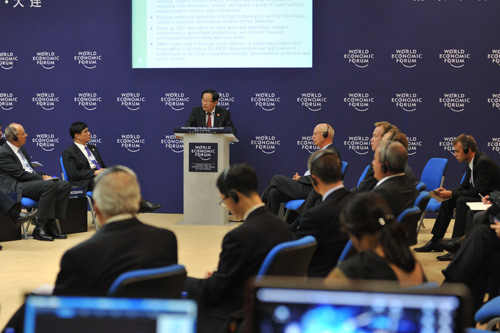
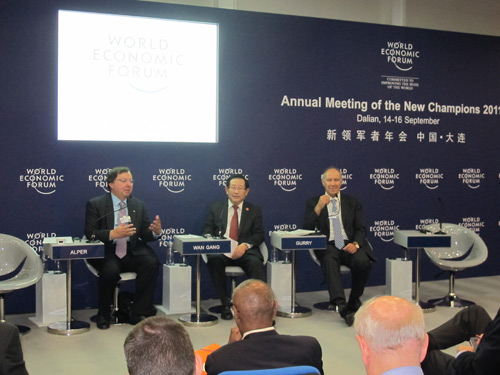
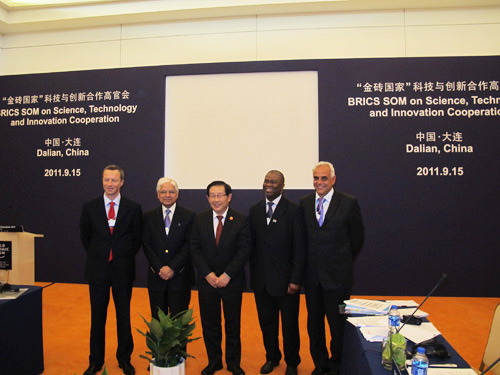
At the invitation of World Economic Forum (WEF) Executive Chairman Klaus Schwab, WAN Gang, Vice-Chairman of Chinese People’s Political Consultative Conference and Chinese Minister of Science and Technology, attended the World Economic Forum New Champions 2011 held on September 14-15 in Dalian.
In the morning of September 15, WAN attended a dialogue meeting staged for young scientists and industrial technology pioneers with the presence of World Intellectual Property Organization (WIPO) Director General Francis Gurry and Canada Science and Technology Innovation Council President Howard Alper. WAN spoke about a range of issues at the forum, including future technology development trends, business opportunities bought up by novel technologies, young people’s innovation and entrepreneurship, and the innovation and entrepreneurial environment in China and associated government policies. He also answered the questions raised by young participants on the relationships between basic and applied research, and the impact of education on innovation and entrepreneurship. Some 50 young scientists and high-tech researchers from different parts of the world attended the dialogue.
In the morning of September 15, WAN also attended a senior officials meeting on technology innovation and cooperation staged for BRIC countries. In his keynote speech, WAN spoke about the major objectives and tasks defined by the national S&T development planning for the 12th five-year period. He said China attaches great importance to technology innovation and associated cooperation mechanisms among BRIC countries, wishing BRIC countries work together in the areas of technology innovation strategies and policies, food safety and sustainable agriculture, climate change, new energy, renewable energy and energy efficiency, basic research, biotechnology, high-tech parks among others. Deputy science ministers and senior officials from Brazil, Russia, India, and South Africa attended the meeting.
In the afternoon of September 15, WAN attended a ministerial meeting on technology innovation co-sponsored by the Chinese Ministry of Science and Technology and the World Economic Forum. Some 20 ministers, entrepreneurs, and experts from various countries attended the seminar. Participants discussed a range of issues, including entrepreneurs’ originality and innovation, education and training talented people, the key role played by technology breakthroughs in promoting high-quality growth among others. WAN made a keynote speech on promoting the quality growth through technology innovation at the meeting. He said S&T development has played a significant role in economic restructuring, transforming the mode of economic growth, and securing an economic growth with quality. WAN also briefed the audiences of the major deployments made by the national S&T development planning for the 12th five-year period, and major measures adopted by China in enhancing international cooperation in the area of science and technology.
During the meeting, WAN also held bilateral talks with Kyrgyz Prime Minister Ata Mba Aliyev and the World Intellectual Property Organization Director General Francis Gurry.
In the afternoon of September 14, WAN held talks with Kyrgyz Prime Minister Ata Mba Aliyev. Both sides reviewed the first China-Eurasia Expo held not long ago in Xinjiang, and the first science ministerial meeting of SCO member states held in May 2010 in Beijing. WAN proposed that a bilateral science and technology cooperation joint committee be established, in an attempt to embark on bilateral cooperation in the areas of water saving agriculture, elite germplasms, fertilizer application reduction, and increasing food production.
In the afternoon of September 15, WAN held talks with World Intellectual Property Organization (WIPO) Director General Francis Gurry. The two sides reviewed with satisfaction the progresses made since the signing of an MOU between Chinese Ministry of Science and Technology and WIPO, and agreed that comprehensive and balanced attention shall be given to the creation, utilization, protection and management of intellectual properties. Both sides also agreed to jointly work on a range of issues in the future, including patent policy and innovation policy, public policy, coordination of public interests among others, in a bid to encourage innovation and promote extensive applications of patented technologies in public domains.
At the noon of September 15, WAN exchanged views with UNDP Deputy Director Rebeca Grynspan on a range of issues, including trilateral agricultural science and technology cooperation in Africa, promoting innovation and entrepreneurship, and adapting to climate change through the South-South S&T cooperation.
In the afternoon of September 15, WAN met with Azerbaijan Minister of Information and Communication Technology Ali Abbasov and his party. Abbasov complimented China's progresses achieved in the areas of electronic information and wireless communication, and thought highly of an array of internationally renowned Chinese companies, including Huawei, ZTE and others. WAN said the two countries will promote the future cooperation in the area of information and communication technology under the framework of bilateral scientific and technological cooperation accord.
In the afternoon of September 15, WAN also exchanged views with Klaus Schwab, World Economic Forum Executive Chairman, on further cooperation.
Chinese Science Minister Met with Swedish Guests
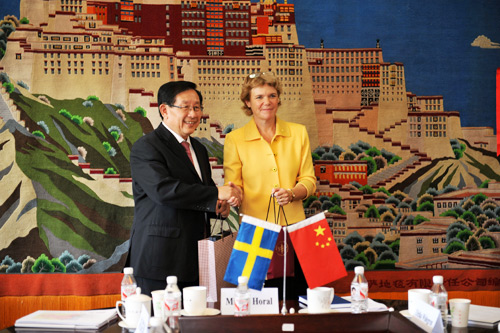
September 19, 2011 – WAN Gang, Chinese Minister of Science and Technology, met with Harriet Wallberg-Henriksson, President of the Swedish Karolinska Institute and her party. Both sides thought highly of the partnerships fostered between Karolinska Institute and Chinese universities and research institutions, and are looking forward to further collaborations in the area of medicine and health.
WAN briefed the other side of the accomplishments China has achieved during the 11th five-year period (2006-2010), especially in the area of biology and medical science. During the 12th five-year plan period (2011-2015), China will continue to enhance the R&D input in the area of medical science and health, in a bid to further raise people's health level, which needs an enhanced role played by international cooperation. Both China and Sweden will strengthen their cooperation in the areas of translational medicine, genomics, stem cells among others, establishing joint health research centers, and facilitating the exchanges between the scientists of two countries. Henriksson made a positive response to the proposal, saying that Sweden is willing to continue to work with China in the area of medicine and health.
China-Germany Innovation Forum
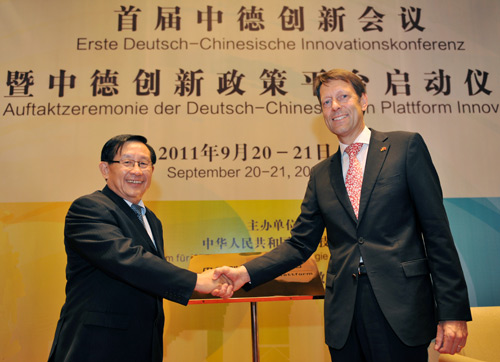
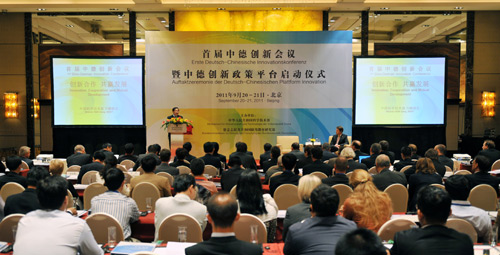
A China-Germany innovation policy platform was launched at the first China-Germany innovation conference held September 20-21 in Beijing. WAN Gang, Chinese Minister of Science and Technology and Georg Schütte, Secretary of State at the Federal Minister of Education and Research, attended the opening ceremony and unveiled the platform. Some 200 delegates from government, industry, and research institutes attended the meeting.
WAN said China and Germany jointly launched the innovative policy platform, in a bid to secure more room for S&T and innovation activities in China, Germany and even in the world. He put forward four proposals: 1) China and Germany will jointly work on innovation strategies, running an innovation policy platform; 2) establish an all-round strategic partnership in the area of electric vehicles, exploring in-depth collaborations on strategic and emerging industries; 3) conduct innovation studies in the area of environmental protection; and 4) strengthen the collaboration in the area of life sciences among others.
Schütte briefed the other side of Germany’s innovation system and strategy, and new research and innovation trends. He said technological innovation and progress became an experience shared by both countries, against the background of global financial crisis,. China and Germany are highly complimentary to one another with great potentials for cooperation. The two countries will embark on a range of cooperation in the area of innovation, including clean water, in the future.
Chinese Vice-Minister Met with UN Guests
September 14, 2011 - ZHANG Laiwu, Chinese Vice-Minister of Science and Technology, met with Rebeca Grynsapn, UN Deputy Secretary-General and Deputy Director of UNDP. ZHANG briefed the guests of China's S&T activities in the rural areas, including innovations and the S&T envoy system. He also expressed his thanks to UNDP’s support to poverty alleviation and agricultural innovation activities in China’s rural areas. During the talk, Grynsapn appreciated China's efforts of sending S&T envoys to the rural areas, helping farmers increase their income and become rich. She expressed the hope to strengthen the collaborations with Chinese Ministry of Science and Technology, improving and diffusing the S&T envoy system, especially to other developing countries through the third collaborators.
Joint Nano School Founded
Not long ago, a College of Nano Science and Technology, jointly established by the University of Science and Technology of China and University of California, Berkeley, was inaugurated in Suzhou. HOU Jianguo, the University of Science and Technology of China President, WANG Hongsheng, Deputy Mayor of Suzhou, and Richard Mathies, Dean of UC Berkeley College of Chemistry, were present at the ceremony. The Nano College will enroll its first batch of 158 full-time graduate students this year, working on six majors, including nano-medicine, nano-chemistry, nano-devices, nano-energy, nano-environment, and nano-catalysis.
China's First Target Aircraft Launched

At 21:16 September 29, 2011 (Beijing time), China successfully blasted off its first target aircraft named Tiangong-I aboard a CZIIFT1 launch vehicle, from the Jiuquan Satellite Launch Center. The unmanned space module is 10.4m long and 3.35m across, allowing a take-off mass around 8.5 tons. Designed for a 2-year in-orbit life, the target aircraft is made up of an experiment module and a resource module. The CZIIFT1 launch vehicle that launched the space module is 52m long with a take-off mass at 493 tons and a carrying capacity of 8.6 tons. Equipped with a novel fairing and an improved booster structure for enhanced carrying capacity, the launch vehicle is an improved model built on CZIIF, without escape system.
Chinese Scientist Won 2011 Lasker Award

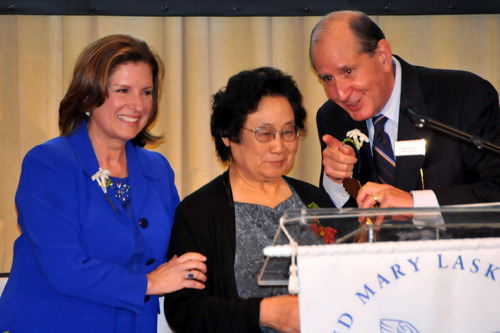
September 23, 2011- TU Youyou, a lifetime fellow of Chinese Academy of Traditional Chinese Medicine, was honored with the Lasker Clinical Research Award, in recognition of her discovery of artemisinin - a new drug that can be used to treat malaria. This is the first time for a Chinese scientist to be honored with the Lasker Award. TU and her collaborators started to work on artemisinin since the 1960s. Inspired by an ancient Chinese literature, TU found artemisinin, and made it a new drug to treat malaria, benefited more than hundred million people in the world. An artemisinin-based combination drug has become a standard malaria treatment plan. The World Health Organization has made artemisinin part of its Essential Drug Catalog.
Three Research Centers for Large Aircraft Engine
AVIC Commercial Aircraft Engine Co., Ltd. announced on September 19, 2011 that it has inaugurated the opening of three research centers in Shanghai, including an aero-engine engineering center, a structural integrity engineering center, and a Shanghai Supercomputer Center branch for AVIC Commercial Aircraft Engine. The development marks the substantive progresses made in large passenger aircraft engine related pre-study and key technology development. According to a plan, Chinese-made large aircraft engine "CJ-1000A" will complete its test mission as a demonstrator in 2016, and put into commercial operation in 2020. The three centers, together with an inclusive and foreign objects inhalation injury engineering center inaugurated last December, have shown China’s determination to master the key technologies of building quality commercial aircraft engines.
Comments or inquiries on editorial matters or Newsletter content should be directed to:
Department of International Cooperation, MOST 15B, Fuxing Road, Beijing 100862, PR China Tel: (8610)58881360 Fax: (8610) 58881364
http://www.most.gov.cn

